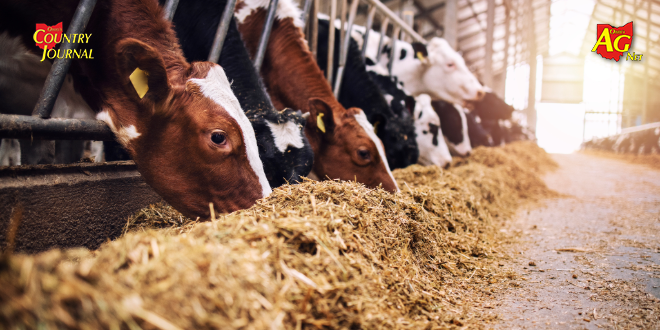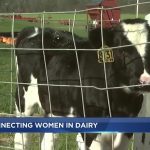
The U.S. Department of Agriculture (USDA), Food and Drug Administration (FDA) and Centers for Disease Control and Prevention (CDC), as well as state veterinary and public health officials from around the country continue to investigate the emerging illness among dairy cows that causes decreased lactation, low appetite, and other symptoms. USDA has since confirmed the presence of HPAI A(H5N1) in additional dairy cattle herds in Idaho, New Mexico, Michigan, and Ohio.
In early April, the Ohio Department of Agriculture (ODA) received confirmation from the USDA National Veterinary Services Laboratory (NVSL) of the detection of HPAI in an Ohio dairy cattle herd. The affected dairy operation in Wood County received cows on March 8, 2024, from a Texas dairy, which later reported a confirmed detection of HPAI A(H5N1). Ohio’s animal health officials were notified when the livestock began showing clinical signs compatible with sick, lactating dairy cows in other states.
Shaun Wellert, D.V.M., is with the Ohio State University College of Food, Agricultural and Environmental Science Agricultural Technical Institute and a co-author for the recent CFAES Fact Sheet “Avian Influenza Detected in Dairy Cattle.”
“This is a really evolving situation. When it started there were reports of strange disease incidents happening in cattle in the Texas Panhandle. A lot of diagnostic tests were coming up negative. The people on the ground there were having a hard time trying to pinpoint what was going on with these cattle and the signs were pretty vague. Then the USDA came out and reported that they isolated avian influenza,” Wellert said. “We’re presuming that wild birds were the cause, but there’s a lot of research and diagnostics that have to go into proving that link. There are still a lot of unknowns. Waterfowl is the natural reservoir that we worry about. We still don’t know where it initially came from in these cow herds in the Texas Panhandle area, but there is a lot of suspicion that it was from waterfowl.”
So far, the HPAI cases in dairy cattle appear to have connections with the original Texas cattle.
“The good news is most all of those cases have direct epidemiologic links to herds that have tested positive in Texas, so movement of animals from those herds to these other states seems to be the cause. Currently there hasn’t been any reported incidence of other spread. If that trend continues, hopefully we can curtail it just by limiting the movement of animals. But again, it’s still a very fluid situation and we’re expecting more information to come out in the days and weeks ahead,” Wellert said. “Currently the ODA hasn’t put on any movement restrictions on, but that can always change. Again, this is a very fluid situation. We have seen some movement restrictions on animals in other states, but currently in Ohio there’s nothing that that is limiting those movements right now.”
In terms of food safety of dairy products, the risks associated with HPAI in dairy cattle are very low. According to the Food and Drug Administration and Centers for Disease and Prevention, there is no concern about the safety of commercially pasteurized dairy products due to both federal animal health requirements and pasteurization.
“USDA has come out multiple times reiterating that there is not a significant risk to the human population from this. Milk from sick animals is required by law to be diverted out of the food supply. We also have pasteurization standards that, if some milk does get in, you will inactivate this virus quite quickly,” Wellert said. “It’s not a virus that survives in the environment for a long time. Most disinfectants easily kill it, pasteurization easily kills it, even just warm temperatures tend to kill it. So, there’s no big risk to humans, which is a really good thing.”
As more information about the situation comes out, farmers should continue biosecurity protocols and watch their cattle closely.
“All farms really should be practicing the standard biosecurity that they always have. There has been at least one reported instance of a high path avian influenza of H5N1 virus infected human as well in Texas. The current recommendation is if you have suspected animals with H5N1on farms there’s some PPE requirements for farm workers that would be recommended. As far as other herds that don’t have suspected cases, it’s standard practice — limiting unnecessary visitors, washing, cleaning boots, washing hands and probably the biggest one is limiting the movement of animals into your herd from a potential source of this,” Wellert said. “Farmers need to be in good communication with their veterinarian and listening to their veterinary professionals and their recommendations for their specific farms. They should be the point person for any questions that they have.”
According to Greg Habing, D.V.M., professor and interim chair of the Ohio State University Department of Veterinary Preventive Medicine in the College of Veterinary Medicine, affected cows have reduced feed intake with drops in milk production, reduced activity, and noticeable “depression.”
“In some cases, the drop in milk production was severe. Most of the cows do not have signs of respiratory disease, a fever is not consistently found. Some of the cows have abnormal manure, either loose or tacky,” Habing said. “Depopulation is not on the table as a solution for herds infected with the Bovine Influenza A virus. In Ohio, the single infected herd has self-imposed movement restrictions for animals on the farm. There haven’t been any new reports of infected herds in Ohio. We don’t yet know the length of the recovery period, but we’re actively working with the infected herd to collect the data necessary to answer these types of questions.”
Other unanswered questions with this situation include the timeframe for milk from affected to return to the food chain.
“We don’t yet have good data on how long the cows infected with influenza A have abnormal milk, or how long the affected cows shed the virus in milk. But again, we’re actively collecting samples and data at the infected farm in Ohio so we can have evidence-based answers,” Habing said. “The treatment is focused on supportive care and anti-inflammatories. For instance, the cows may be dehydrated, and producers can help correct this with oral fluids. We don’t know yet if these treatments substantially speed the recovery for affected cows. The anti-inflammatories (e.g. flunixin meglumine) have a milk and meat withhold, and producers should follow label instructions and veterinary written protocols to avoid residues.”
As more is learned about this, veterinarians and dairy producers alike will continue to closely monitor the situation.
“This is a critical issue for the dairy industry. Preventing the spread of the virus is very important to preserve animal health and avoid the economic losses for producers. All producers need to work with their veterinarians to create comprehensive biosecurity plans designed to exclude the virus from the farm,” Habing said. “This includes, among many other things, avoiding importing high-risk animals onto the farm, monitoring personnel movements onto the farm, and working to avoid wild bird access to the farm and the feed. Producers that notice signs consistent with the virus, or an unusual number of cows that drop in milk production, should work directly with their veterinarians to consider additional diagnostics. Some states, including Pennsylvania, have already instituted animal movement restrictions and testing requirements from dairy breed cattle from affected states. Voluntary measures to control the spread will be important to avoid these types of regulatory restrictions and maintain confidence from consumers.”
Stay updated on developments with HPAI in dairy cattle from the ODA at agri.ohio.gov/home. An Ohio State University resource is available for affected diary producers at: dairy.osu.edu/sites/dairy/files/imce/PDF/Dairy%20Cattle%20HPAI%20Factsheet%20%231%20Final.pdf.
You can now read the most important #news on #eDairyNews #Whatsapp channels!!!
🇺🇸 eDairy News INGLÊS: https://whatsapp.com/channel/0029VaKsjzGDTkJyIN6hcP1K
























